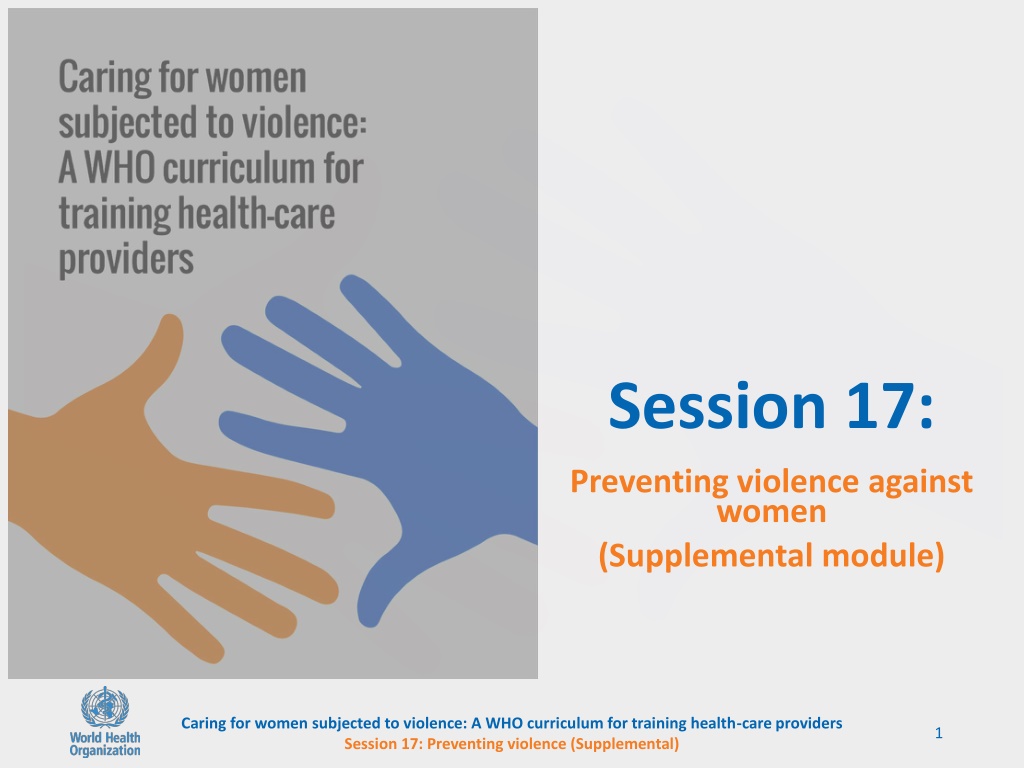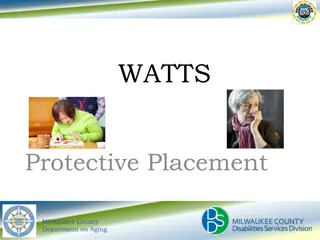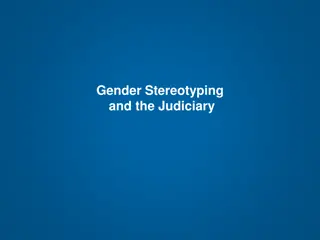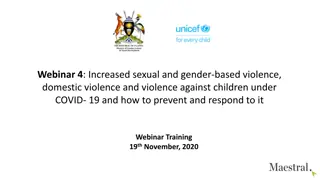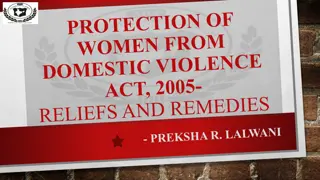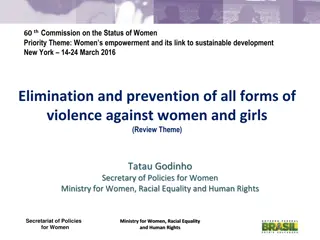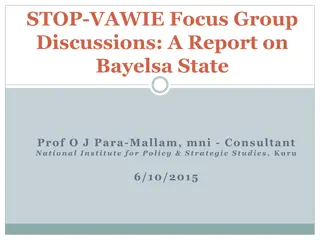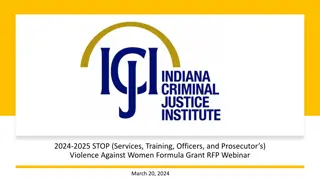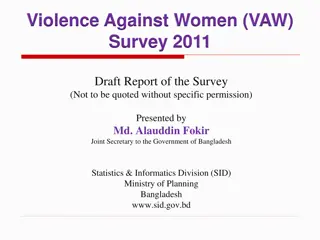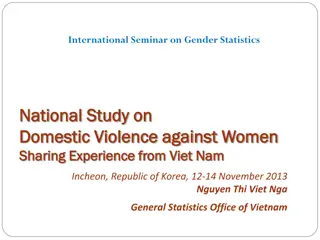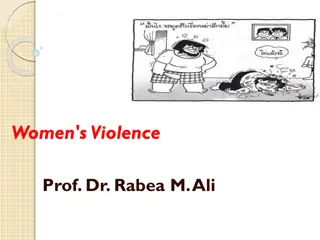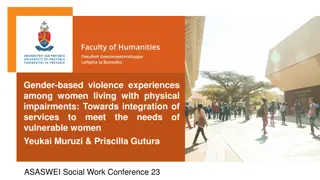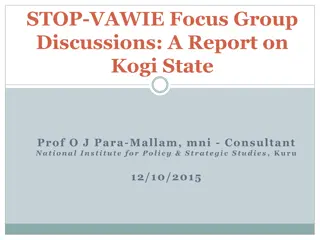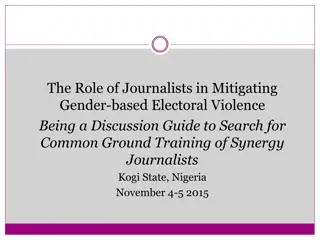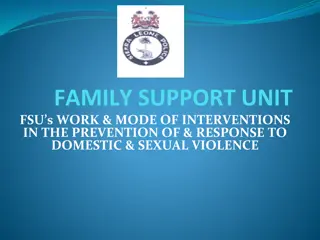Understanding Risk and Protective Factors in Preventing Violence Against Women
Violence against women is preventable, and understanding risk and protective factors is crucial in developing effective prevention strategies. This WHO curriculum focuses on enhancing protective factors, minimizing risk, and implementing prevention programs to address violence against women. It highlights the importance of recognizing factors that contribute to violence and the role of health-care providers in promoting prevention efforts.
Download Presentation

Please find below an Image/Link to download the presentation.
The content on the website is provided AS IS for your information and personal use only. It may not be sold, licensed, or shared on other websites without obtaining consent from the author. Download presentation by click this link. If you encounter any issues during the download, it is possible that the publisher has removed the file from their server.
E N D
Presentation Transcript
Session 17: Preventing violence against women (Supplemental module) Caring for women subjected to violence: A WHO curriculum for training health-care providers Session 17: Preventing violence (Supplemental) 1
Learning objective Demonstrate clinical skills appropriate to one s profession and specialty to respond to violence against women Competencies Understand how to enhance protective factors, minimize risk and mitigate harmful consequences of VAW Know about multisectoral prevention strategies that the health sector can promote or advocate with other sectors Identify prevention strategies that can be implemented by health-care providers/settings Caring for women subjected to violence: A WHO curriculum for training health-care providers Session 17: Preventing violence (Supplemental) 2
Violence against women is preventable Caring for women subjected to violence: A WHO curriculum for training health-care providers Session 17: Preventing violence (Supplemental) 3
Risk and protective factors Definition: Aspects of a person (or group), experience or environment that make it more likely (risk factors) or less likely (protective factors) that women will experience violence or that men will perpetrate violence Not all risk factors are causal The more risk factors, the greater the likelihood of violence There are risk and protective factors both for experiencing violence and for perpetrating violence Many risk factors are related to multiple outcomes for example, IPV, sexual violence, child maltreatment The most effective prevention programmes work on both reducing risks and enhancing protective factors Caring for women subjected to violence: A WHO curriculum for training health-care providers Supplemental session 17: Preventing violence Caring for women subjected to violence: A WHO curriculum for training health-care providers Session 17: Preventing violence (Supplemental) 4
Risk and protect ive factors can occur at multiple levels Caring for women subjected to violence: A WHO curriculum for training health-care providers Session 17: Preventing violence (Supplemental) 5
Caring for women subjected to violence: A WHO curriculum for training health-care providers Session 17: Preventing violence (Supplemental) 6
Individual Risk factor Intervention Experiencing or witnessing violence in childhood Address childhood abuse Improve access to education & social skills Reduce harmful drinking Low education Harmful use of alcohol Personality disorders Early identification & treatment of conduct disorders Caring for women subjected to violence: A WHO curriculum for training health-care providers Session 17: Preventing violence (Supplemental) 7
Relationship Risk factor Intervention Men s control over women Working with men & boys to promote respectful and consensual relationships and gender-equitable attitudes & behaviours Marital dissatisfaction Promoting gender-equitable attitudes & behaviours / healthy relationship skills / conflict resolution skills among men, women & couples Multiple partners Caring for women subjected to violence: A WHO curriculum for training health-care providers Session 17: Preventing violence (Supplemental) 8
Community level Risk factor Intervention Unequal gender norms that condone violence against women; weak community sanctions against violence against women Promoting equitable gender norms through community mobilization, schools and religious institutions, edutainment, mass media Caring for women subjected to violence: A WHO curriculum for training health-care providers Session 17: Preventing violence (Supplemental) 9
Societal level Risk factor Intervention Harmful use of alcohol Policies & programmes to reduce harmful use of alcohol Laws, policies & programmes that promote women s access to employment, microcredit or cash transfers and girls access to education Interventions addressing social & gender norms; laws that prohibit violence against women Women s lack of access to education & employment Gender & social norms accepting violence/ ideologies of male entitlement Strengthen & enforce legislation prohibiting VAW, promoting equality in marriage & divorce, property & inheritance Lack of or poor enforcement of laws against VAW Caring for women subjected to violence: A WHO curriculum for training health-care providers Session 17: Preventing violence (Supplemental) 10
Violence against women is preventable Caring for women subjected to violence: A WHO curriculum for training health-care providers Session 17: Preventing violence (Supplemental) 11
Caring for women subjected to violence: A WHO curriculum for training health-care providers Supplemental session 17: Preventing violence 13
https://www.youtube.com/watch?v=kYu3mFjuhTM&ab_channel=MediaHRP Caring for women subjected to violence: A WHO curriculum for training health-care providers Session 17: Preventing violence (Supplemental) 14
Caring for women subjected to violence: A WHO curriculum for training health-care providers Supplemental session 17: Preventing violence 15
Caring for women subjected to violence: A WHO curriculum for training health-care providers Session 17: Preventing violence (Supplemental) 16
Exercise 17.1. Assessing risk and protective factors Problem tree Lifeline Case study 1: Adolescent girl 16 years Case study 2: Young man 25 years Note: Different emphasis in the 2 exercises Time to work : 45 minutes Time for plenary: 30 minutes Caring for women subjected to violence: A WHO curriculum for training health-care providers Session 17: Preventing violence (Supplemental) 17
Exercise 17.1. Case studies Adolescent girl: 16-year-old girl from family of 6, has experienced sexual abuse since childhood. Young man: 25-year-old married man. Has sexually transmitted infections (STIs). Abuses his wife and their 2 children. Caring for women subjected to violence: A WHO curriculum for training health-care providers Session 17: Preventing violence (Supplemental) 18
Exercise 17.1. Lifeline Draw/map life stories of 16-year-old girl on a flip chart page. Current age 16 Positive events/ protective factors Age in years Negative events/ risk factors 1. 1. What interventions can re What interventions can re- -enforce and amplify the positive enforce and amplify the positive events/protective factors? What interventions can mitigate or events/protective factors? What interventions can mitigate or reduce the negative events or risk factors? reduce the negative events or risk factors? Which interventions can the health sector implement directly and Which interventions can the health sector implement directly and which through advocacy with other sectors? Mark these with a which through advocacy with other sectors? Mark these with a star. star. 2. 2. Caring for women subjected to violence: A WHO curriculum for training health-care providers Session 17: Preventing violence (Supplemental) 19
Exercise 17.1. Problem tree Imagining the life of the 25- year-old man abusing his wife, draw the tree. Place causes of the problems in the roots, the risk factors in the tree trunk and the consequences on the branches. What interventions can address What interventions can address risk factors and root causes and risk factors and root causes and mitigate consequences? mitigate consequences? Which interventions can the health Which interventions can the health sector implement directly or sector implement directly or through advocacy with other through advocacy with other sectors? Mark these with a star. sectors? Mark these with a star. Consequences of the violence 1. 1. Risk factors 2. 2. Root causes of the violence Caring for women subjected to violence: A WHO curriculum for training health-care providers Session 17: Preventing violence (Supplemental) 20
Exercise 17.2. Solutions Tree Each group/table brainstorms for 10 minutes. On three Post-its write: 1. One prevention message to communicate to patients, communities 2. One facility activity where prevention messages can be incorporated 3. One activity outside the facility where you can promote prevention messages Stick post-its on the solutions tree where shown. Prevention message Facility activity Activity outside the facility Caring for women subjected to violence: A WHO curriculum for training health-care providers Session 17: Preventing violence (Supplemental) 21
Key messages Violence against women is preventable The health sector has a role to play in prevention Identify interventions to enhance protective factors, reduce risks and harmful consequences The RESPECT framework identifies promising prevention strategies and guiding principles for implementation As health-care managers, you can: o incorporate messages about prevention into health promotion activities o implement interventions through services, includingfor mental health, alcohol and drug use problems/conditions o advocate for preventionwith peers, communities and leaders Caring for women subjected to violence: A WHO curriculum for training health-care providers Session 17: Preventing violence (Supplemental) 22
